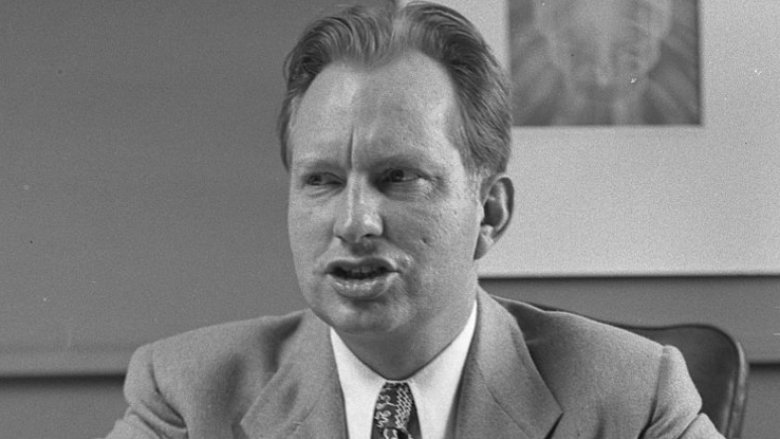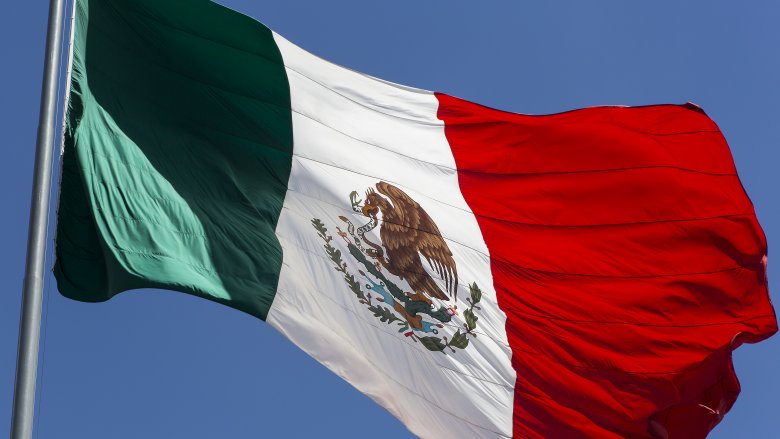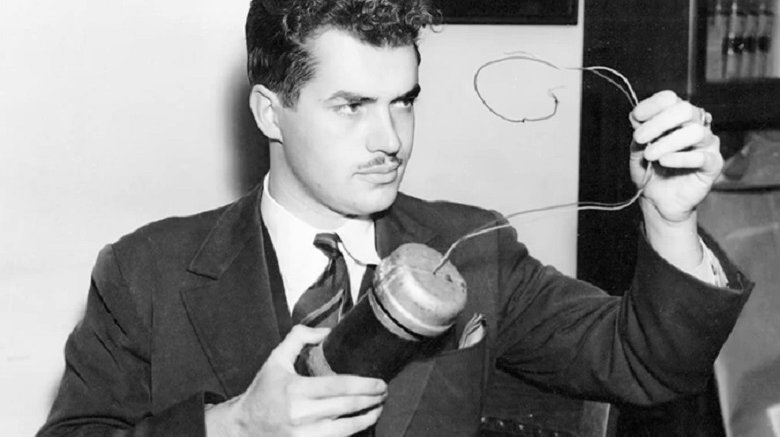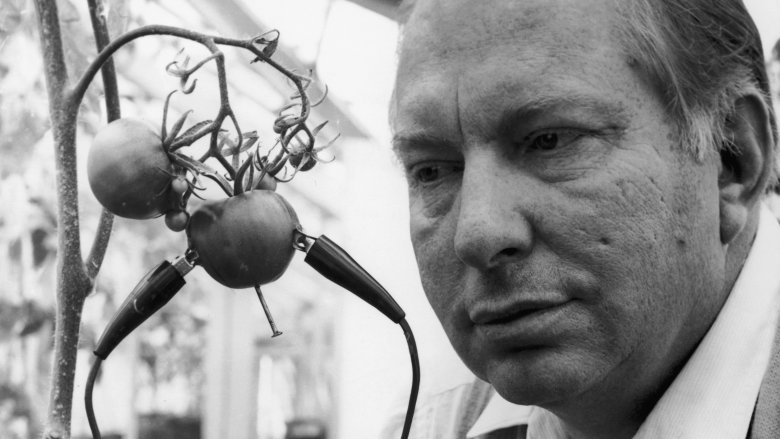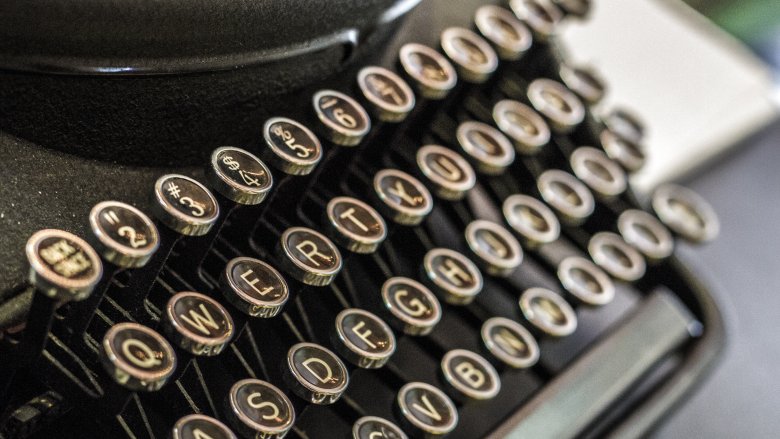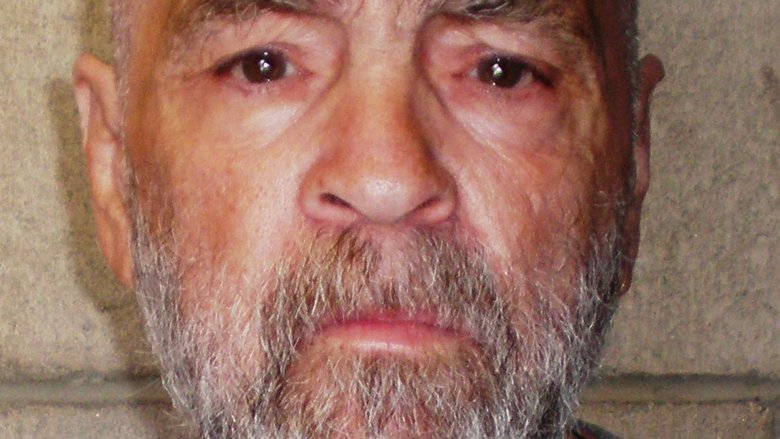The Untold Truth Of L. Ron Hubbard
In 1950, a bizarre self-help guide called Dianetics hit bookshelves across the United States. Over the next seven decades, this oddball philosophy would morph into Scientology, the infamous cult of engrams, E-meters, and aliens. But while it's probably best known thanks to South Park and the ramblings of Tom Cruise, Scientology is no joke. The group earns around $200 million annually, allegedly imprisons wayward members, and will harass anyone deemed an enemy of the church.
So how did Scientology get started? Well, blame a red-headed sci-fi writer named Lafayette Ronald "L. Ron" Hubbard. Known affectionately to his followers as LRH, Hubbard went from penning pulp fiction to running one of the biggest con jobs in American — nay, world — history. (The man allegedly once said, "If you want to make any money, the only way to do it is to make a religion so the government wouldn't take it all.") And naturally, being such a larger-than-life figure, Hubbard's story is full of madness, misadventures, and untold truths.
His childhood was full of lies
L. Ron Hubbard dreamed up a religion involving an evil galactic emperor and extraterrestrial ghosts, but Hubbard didn't just have a story about the creation of the world. Every other word that came out of his mouth was a half-truth or a hoax, especially when it came to his own life. In order to make himself seem like a modern-day messiah, Hubbard had to beef up his biography.
According to Hubbard, he was the youngest Eagle Scout in history and spent a lot of his childhood working as a cowboy on his family's gigantic ranch in Montana. At age 4, he met a Blackfoot medicine man who made him a blood brother. Then Hubbard took a grand tour across Asia where he visited China and "was made a lama priest after a year as a neophyte." He claimed to have lived with Tibetan bandits, befriended Manchurian warlords, and even taught a South Pacific tribe not to worry about the monstrous rumblings coming from inside a cave as it was just an underground river.
Needless to say, this is 99 percent nonsense. Yeah, Hubbard did visit China as a boy, but he hated the place. As for the Eagle Scout claim, he did in fact reach that rank, but there's no way to know if he was the youngest as the Boy Scouts don't keep track of Eagle Scout ages. The Blackfoot claim is complete nonsense, as the Blackfeet don't have a blood brother ritual. The Hubbards didn't have a giant ranch, but the man's lies didn't stop with childhood. Hubbard would later say he was a nuclear physicist, when in reality, he couldn't even pass physics. As one judge put it in a 1985 case, L. Ron Hubbard was "a pathological liar."
He almost started a war with Mexico
From 1941 to 1950, L. Ron served as a lieutenant with the U.S. Navy. Of course, he was far from what you'd call an exemplary officer. For most of his military career, Hubbard was a desk jockey, and while that's totally cool, Hubbard later claimed he earned 21 medals, including the Purple Heart. In reality, Hubbard never saw action and only received four non-combat medals.
He even spent two days chasing the Japanese off the Oregon coast. Commanding a sub hunter, Hubbard was patrolling the Pacific when he encountered two enemy submarines. He began firing depth charges left and right, and soon, there were five ships and two blimps hunting for the evasive enemy. However, after Hubbard wasted two days, his superiors realized there weren't any Japanese lurking in the water. Instead, Hubbard was battling a magnetic deposit.
Shockingly, Hubbard would top his own stupidity in 1943 when he almost started a war with Mexico. He unwittingly took his ship into Mexican waters and began firing near the Coronado Islands. There were members of the Mexican Navy on the islands, and some shells were even reported to hit land. After the incident, the Mexican military said they would sink the next ship that sailed into their territory, and Hubbard was relieved of his command.
Later on, Hubbard would tell multiple people he'd been wounded during the war. He told some people he'd been shot in the back, while others heard that a bomb had exploded in his face. Hubbard then claimed he'd healed his war wounds with the power of Scientology, but as the LA Times pointed out, the only thing Hubbard suffered during World War II was a nasty ulcer.
He kept the world's weirdest diary
While he eventually created one of the world's largest cults, L. Ron Hubbard suffered from self-esteem issues, especially during the 1940s. Hoping to boost his confidence, Hubbard wrote the world's weirdest diary. Known as his "Affirmations" (aka "Admissions"), these writings contained some pretty twisted platitudes, lines that Hubbard most likely recorded on tape and then listened to as part of a bizarre, magical self-help ritual. Granted, it's not 100 percent confirmed that Hubbard wrote the "Affirmations." However, the church has done its best to keep the documents a secret, and the group has never denied the documents were real. In fact, an attorney working for Hubbard's wife basically admitted Hubbard was the mastermind behind these horribly awkward admissions.
So what exactly was Hubbard writing? Well, some of the stranger lines read, "I can have no doubts in my psychic powers," and, "You can sing beautifully. Your voice can imitate any singer." He also tried to convince himself that "Men are your slaves. Elemental spirits are your slaves." He even predicted he would live for centuries, telling himself, "You will live to be 200 years old."
Not surprisingly, a lot of his "Affirmations" revolved around sex, and this is where things get really cringe-worthy. "You are as sensitive and sexy as Pan," Hubbard allegedly wrote, before adding, "Singing to [women], for you sing like a master, destroys their will to resist." In another passage, Hubbard said, "Your sexual power is magnificent and they know it. If they are afraid of it, that is their loss. You are not affected by it." But for all his faith in his manly abilities, Hubbard admitted multiple times that he suffered from incredibly low libido, and that he wanted to use self-hypnotism to restore his potency. Yeah, it's embarrassing stuff, so it's easy to see why the Church doesn't like affirming these humiliating "Affirmations."
He was a magician who tried to create the Antichrist
Jack Parsons (above) was a key figure in the story of space travel. He invented solid rocket fuel and co-founded the Jet Propulsion Laboratory, one of the most important organizations in NASA history. But when Parsons wasn't tinkering with rockets, he was practicing sex magic and working his way higher and higher in the Ordo Templi Orientis, a society led by the infamous pagan Aleister Crowley.
Parsons used the cash he made from selling rockets to buy a mansion nicknamed "The Parsonage." The place became a hangout for all sorts of weirdos — sci-fi writers, witches, nuclear scientists — and into this magical madness walked L. Ron Hubbard, ready to make something supernatural happen. Hubbard and Parsons hit it off immediately, and the two decided to do a heavy-duty ritual called "The Babalon Working." The plan was to summon the goddess Babalon, aka "The Scarlet Woman," a powerful entity that would give birth to the Antichrist. This unusual experiment involved Hubbard chanting while Parsons, um, had a good time going solo. The two also performed spells involving swords and animal blood until one day a woman named Marjorie Cameron arrived at the Parsonage. Parsons was convinced this was the Scarlet Woman, so he began sleeping with her as Hubbard stood by, reciting magical phrases in the hopes of impregnating Cameron with the fabled "Moonchild."
Of course, they never summoned the Antichrist, and this magical partnership majorly backfired when Parsons' girlfriend, Sara Northrup, fell in love with Hubbard. Making matters worse, Hubbard suggested that Parsons give him $20,000 so he and Sara could drive to Florida, buy a few boats, and then sail them back to Parsons' California home and they could go into the ship-selling business together. Only instead of keeping his end of the deal, Hubbard took off with both Sara and the cash, leaving poor Parsons with nothing but spells and regrets.
He thought he could communicate with plants
Christianity has the crucifix, Islam has prayer rugs, and Scientology has the E-meter, a device that's essentially a souped-up lie detector. So what's the point of this E-meter? Well, the whole goal of Scientology is to reach a level of enlightenment called "clear." Once you're there, you'll supposedly become superhuman, free of physical and psychological illness. In order to reach "clear," you have to go through a process called "auditing," which forces you to confront negative memories ("engrams") from your past.
Plus, alien ghosts called thetans play into all this. It's complicated.
During these auditing processes, the subject holds onto the E-meter while the auditor asks a series of strange questions. When the subject answers, a needle on the meter pings back and forth (caused by an electric current), and the auditor then "determines" whether or not the subject is free from the engrams and can progress to the next level of Scientology. Naturally, this all costs a lot of money.
So what does this have to do with talking to plants? Well, after starting the Church of Scientology, Hubbard made his way over to England, bought an estate in Sussex, and tried impressing local reporters by claiming he was a plant expert. In fact, when a photographer showed up, Hubbard tested his E-meter on a tomato. He hooked up the device to the little red fruit, watched the needle go back and forth, and then declared that tomatoes feel pain and "scream when sliced." Naturally, the photo and his outrageous claims attracted quite a bit of publicity, making Hubbard a laughingstock in England until he was kicked out of the country in 1969.
He's behind one of the largest ever infiltrations of the US government
It's no secret that Scientology is an incredibly expensive cult, one that earns hundreds of millions each year. And one of the keys to making all that sweet moolah is the Church's tax-exempt status. However, Scientology has had a pretty rocky relationship with the IRS over the years, especially when the feds revoked its tax status in 1967. The cult was left high and dry until 1993, when the feds reversed their decision, but during those financially weird years, Hubbard waged war against the government, hoping to get revenge on the IRS. And while that might sound like a foolhardy move, the man actually pulled off one of the largest ever infiltrations of the U.S. government.
Hubbard launched his undercover campaign in 1973, dubbing it "Operation: Snow White." But while LRH was the man behind the plan, the actual plot was carried out by the Guardian's Office, basically the CIA of Scientology. The group was run by Hubbard's wife, Mary Sue, and Snow White involved Scientologists getting jobs in government buildings and stealing documents related to the cult. Spies also bugged government buildings, and before the Church was busted in 1977, there were around 5,000 agents stealing thousands of documents from right under Uncle Sam's nose. When Snow White was finally exposed, 11 high-ranking Scientologists, including Mary Sue, were tossed behind bars. As for Hubbard, he was listed as an unindicted co-conspirator and was never charged. In other words, you could say Hubbard was in the clear.
He had an army of teenage girls
In 1967, L. Ron Hubbard bought a fleet of ships and created the Sea Org, a seafaring sect meant for die-hard Scientologists. Hubbard himself took up residence on the flagship Apollo, and after dubbing himself the Commodore, Hubbard and his followers set sail across the Atlantic.
But life in the Sea Org wasn't a lot of fun. Hubbard actually created the organization because he was under criminal investigation in multiple countries, so he figured an extended ocean cruise was just the ticket. And if a Sea Org member committed the slightest infraction, they were severely punished. Some were imprisoned in lockers, while others were tossed overboard. And it wasn't like you could leave: Sea Org members signed a billion-year contract.
But without a doubt, the weirdest part of Sea Org was the Commodore's Messenger Organization, perhaps the most powerful clique in Hubbard's seafaring operation. The Messengers were Hubbard's personal assistants, following him everywhere and delivering orders to the rest of the ship. And while there were a few boys here and there (current Scientology president David Miscavige was a member), most of the Messengers were girls, ranging in age from 11 to 16. According to ex-Scientologist Kate Bornstein, there was nothing explicit going on between Hubbard and the girls, but still, he made them do some icky stuff.
Messengers were trained to do spot-on impressions of Hubbard when delivering his commands. They were also in charge of keeping the temperature in his room just right, following him around with ashtrays, and even dressing him. As the LA Times put it, "[Hubbard] taught them how to sprinkle powder in his socks and gently slip them on so as not to pull the hairs on his legs." They combed his hair, gave him massages, and applied skin cream to his face. For religion!
He's the most prolific author in history
Before starting his church in 1954, L. Ron Hubbard earned his living as a pulp fiction writer, churning out story after story across numerous genres. He sold his first story in February 1934, an adventure tale called "The Green God" that featured a heroic American killing a bunch of Chinese bad guys. (Nobody ever accused Hubbard of being politically correct.) He published a Western in 1937 titled Buckskin Brigades, a book about a white adventurer adopted by the Blackfeet, and his first-ever sci-fi story was "The Dangerous Dimension," which followed a scientist who can't stop teleporting to whatever place he's thinking about.
According to author Alec Nevala-Lee, Hubbard "published over four million words of fiction in his lifetime," so it's not that surprising to learn Hubbard has some accomplished some impressive achievements. According to Guinness World Records, Hubbard holds the records for both the "most published work by one author" (a total of 1,084) and the "most translated author, same book" (70 translations of The Way to Happiness). Hubbard also has multiple bestsellers to his name, although that comes with a bit of a caveat. As pointed out by the LA Times, Hubbard's book sales have been boosted by Scientologists who swarm stores, buy as many copies as possible, and even allegedly return the books to the Church's publishing company so they can be sold again. The hustle is real.
He thought he was a musical genius
Near the end of his life, L. Ron Hubbard fancied himself a musical savant, composing several albums that boggle the mind and burst the eardrums. His first album, Space Jazz, was released in 1982. It was meant to accompany his notorious book, Battlefield Earth, but even though it featured jazz legend Chick Corea, the result was a mess of a soundtrack, complete with every sound effect imaginable, from laser blasts to horse noises. However, if you're a fan of the Fairlight CMI, then this is the album for you.
Hubbard's next three albums were published posthumously. Mission Earth, inspired by Hubbard's book of the same name, was performed by Edgar Winter, who couldn't salvage Hubbard's stilted lyrics. The Road to Freedom was released in 1986, and it basically serves as a Scientology tract, performed by musical missionaries John Travolta and Frank Stallone. Hubbard himself even makes a from-the-grave cameo at the end, performing a song called "L'Envoi Thank You for Sharing," which is just as amazing as you might expect. The tetralogy was finally completed in 2001, with The Joy of Creating, an album featuring evangelistic numbers from Isaac Hayes and Doug E. Fresh.
But even before Hubbard's final years, the man was desperately trying to churn out the hits. Back when he was still commandeering the Sea Org, Hubbard managed and composed for a Scientology jazz band called The Apollo Stars. The group performed aboard his boat, the Apollo, and in 1974, they dropped an album called Power of Source that's actually pretty catchy compared to Hubbard's later work.
He helped create Charles Manson
With his scraggly hair and swastika tattoo, Charles Manson is an icon of murder and mayhem. But while Manson probably would have formed his bloodthirsty family without the help of L. Ron Hubbard, the founder of Scientology did play a part in the tragic story of Sharon Tate's death.
While serving time in prison, Manson came across Hubbard's self-help tome, Dianetics, and found several ideas to be quite intriguing. Reading Hubbard's book, Manson learned new ways to manipulate people. As author Jeff Guinn explains, Manson realized he could attract troubled and self-loathing women by convincing them "that they didn't have to be crippled by the past, that they were immortal spirits temporarily trapped in their bodies, that they were basically good and capable of achieving anything." And evidently, these tricks worked pretty well.
Manson also briefly converted to Scientology, not because he truly believed Hubbard's line but because he knew it would help him get out of jail. Prison officials were pleased when inmates found religion, and with his new positive outlook on life, the prison brass were fooled into thinking Manson was becoming a better person. So when he was released in 1967 — having gleaned techniques and ideas from writers like Hubbard, Robert Heinlein, and Dale Carnegie — Manson created his own freaky religion, which The New York Times called "an idiosyncratic mix of Scientology, hippie anti-authoritarianism, Beatle lyrics, the Book of Revelation, and the writings of Hitler."
